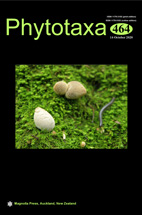Abstract
A morphological study based on light microscopy and scanning electron microscopy describing three new Pseudostaurosira species from mountain streams in Central Mexico is presented herein. Epilithon and water samples for physico-chemical analyses were collected from eleven mountain streams in the Basin of Mexico, located within the Trans-Mexican Volcanic Belt. The bipolar Pseudostaurosira carmonae and P. caballeroae, and the tripolar P. iztaccihuatlii are described from Coaxcacoaco, San Rafael and Ameca streams, located at elevations above 2600 m. These streams were characterized by cold, well oxygenated, and neutral to slightly alkaline water with low conductivity and low nutrient concentration, descending from Mount Tlaloc and Iztaccihuatl volcano in the south eastern part of the basin. No teratological features were observed in either of these taxa, nor an intermediate state between the co-occurring bipolar and tripolar forms. The ultrastructure features (pore structure and spines position) were consistent with the defining characteristics of the genus Pseudostaurosira. This study contributes to further unravelling the freshwater diatom flora of Mexico, while denoting the importance of protecting and studying aquatic ecosystems in this overpopulated region of the Mexico.

